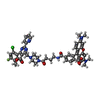+ データを開く
データを開く
- 基本情報
基本情報
| 登録情報 | データベース: PDB / ID: 6bvn | |||||||||
|---|---|---|---|---|---|---|---|---|---|---|
| タイトル | Cryo-EM Structure of Hepatitis B virus T=3 capsid in complex with the fluorescent allosteric modulator HAP-TAMRA | |||||||||
 要素 要素 | Capsid protein | |||||||||
 キーワード キーワード | VIRUS LIKE PARTICLE / capsid / CpAM / antiviral / fluorescent | |||||||||
| 機能・相同性 |  機能・相同性情報 機能・相同性情報microtubule-dependent intracellular transport of viral material towards nucleus / T=4 icosahedral viral capsid / viral penetration into host nucleus / host cell / host cell cytoplasm / symbiont entry into host cell / structural molecule activity / DNA binding / RNA binding / identical protein binding 類似検索 - 分子機能 | |||||||||
| 生物種 |  Hepatitis B virus genotype D subtype adw (ウイルス) Hepatitis B virus genotype D subtype adw (ウイルス) | |||||||||
| 手法 | 電子顕微鏡法 / 単粒子再構成法 / クライオ電子顕微鏡法 / 解像度: 4 Å | |||||||||
 データ登録者 データ登録者 | Schlicksup, C. / Wang, J.C. / Zlotnick, A. | |||||||||
| 資金援助 |  米国, 1件 米国, 1件
| |||||||||
 引用 引用 |  ジャーナル: Elife / 年: 2018 ジャーナル: Elife / 年: 2018タイトル: Hepatitis B virus core protein allosteric modulators can distort and disrupt intact capsids. 著者: Christopher John Schlicksup / Joseph Che-Yen Wang / Samson Francis / Balasubramanian Venkatakrishnan / William W Turner / Michael VanNieuwenhze / Adam Zlotnick /  要旨: Defining mechanisms of direct-acting antivirals facilitates drug development and our understanding of virus function. Heteroaryldihydropyrimidines (HAPs) inappropriately activate assembly of ...Defining mechanisms of direct-acting antivirals facilitates drug development and our understanding of virus function. Heteroaryldihydropyrimidines (HAPs) inappropriately activate assembly of hepatitis B virus (HBV) core protein (Cp), suppressing formation of virions. We examined a fluorophore-labeled HAP, HAP-TAMRA. HAP-TAMRA induced Cp assembly and also bound pre-assembled capsids. Kinetic and spectroscopic studies imply that HAP-binding sites are usually not available but are bound cooperatively. Using cryo-EM, we observed that HAP-TAMRA asymmetrically deformed capsids, creating a heterogeneous array of sharp angles, flat regions, and outright breaks. To achieve high resolution reconstruction (<4 Å), we introduced a disulfide crosslink that rescued particle symmetry. We deduced that HAP-TAMRA caused quasi-sixfold vertices to become flatter and fivefold more angular. This transition led to asymmetric faceting. That a disordered crosslink could rescue symmetry implies that capsids have tensegrity properties. Capsid distortion and disruption is a new mechanism by which molecules like the HAPs can block HBV infection. | |||||||||
| 履歴 |
|
- 構造の表示
構造の表示
| ムービー |
 ムービービューア ムービービューア |
|---|---|
| 構造ビューア | 分子:  Molmil Molmil Jmol/JSmol Jmol/JSmol |
- ダウンロードとリンク
ダウンロードとリンク
- ダウンロード
ダウンロード
| PDBx/mmCIF形式 |  6bvn.cif.gz 6bvn.cif.gz | 91.2 KB | 表示 |  PDBx/mmCIF形式 PDBx/mmCIF形式 |
|---|---|---|---|---|
| PDB形式 |  pdb6bvn.ent.gz pdb6bvn.ent.gz | 70.3 KB | 表示 |  PDB形式 PDB形式 |
| PDBx/mmJSON形式 |  6bvn.json.gz 6bvn.json.gz | ツリー表示 |  PDBx/mmJSON形式 PDBx/mmJSON形式 | |
| その他 |  その他のダウンロード その他のダウンロード |
-検証レポート
| 文書・要旨 |  6bvn_validation.pdf.gz 6bvn_validation.pdf.gz | 1.2 MB | 表示 |  wwPDB検証レポート wwPDB検証レポート |
|---|---|---|---|---|
| 文書・詳細版 |  6bvn_full_validation.pdf.gz 6bvn_full_validation.pdf.gz | 1.2 MB | 表示 | |
| XML形式データ |  6bvn_validation.xml.gz 6bvn_validation.xml.gz | 29.2 KB | 表示 | |
| CIF形式データ |  6bvn_validation.cif.gz 6bvn_validation.cif.gz | 41.7 KB | 表示 | |
| アーカイブディレクトリ |  https://data.pdbj.org/pub/pdb/validation_reports/bv/6bvn https://data.pdbj.org/pub/pdb/validation_reports/bv/6bvn ftp://data.pdbj.org/pub/pdb/validation_reports/bv/6bvn ftp://data.pdbj.org/pub/pdb/validation_reports/bv/6bvn | HTTPS FTP |
-関連構造データ
- リンク
リンク
- 集合体
集合体
| 登録構造単位 | 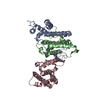
|
|---|---|
| 1 | x 60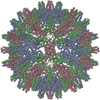
|
| 2 |
|
| 3 | x 5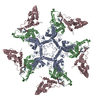
|
| 4 | x 6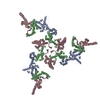
|
| 5 | 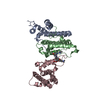
|
| 対称性 | 点対称性: (シェーンフリース記号: I (正20面体型対称)) |
- 要素
要素
| #1: タンパク質 | 分子量: 16791.104 Da / 分子数: 3 / 断片: UNP residues 1-149 / 変異: C48A, C61A, C107A / 由来タイプ: 組換発現 由来: (組換発現)  Hepatitis B virus genotype D subtype adw (ウイルス) Hepatitis B virus genotype D subtype adw (ウイルス)発現宿主:  #2: 化合物 | ChemComp-E9D / | |
|---|
-実験情報
-実験
| 実験 | 手法: 電子顕微鏡法 |
|---|---|
| EM実験 | 試料の集合状態: PARTICLE / 3次元再構成法: 単粒子再構成法 |
- 試料調製
試料調製
| 構成要素 | 名称: Hepatitis B virus T=3 capsid / タイプ: VIRUS / Entity ID: #1 / 由来: RECOMBINANT | |||||||||||||||
|---|---|---|---|---|---|---|---|---|---|---|---|---|---|---|---|---|
| 由来(天然) | 生物種:  Hepatitis B virus genotype D subtype adw (ウイルス) Hepatitis B virus genotype D subtype adw (ウイルス)株: isolate United Kingdom/adyw/1979 | |||||||||||||||
| 由来(組換発現) | 生物種:  | |||||||||||||||
| ウイルスについての詳細 | 中空か: YES / エンベロープを持つか: NO / 単離: OTHER / タイプ: VIRUS-LIKE PARTICLE | |||||||||||||||
| 緩衝液 | pH: 7.5 | |||||||||||||||
| 緩衝液成分 |
| |||||||||||||||
| 試料 | 濃度: 10 mg/ml / 包埋: NO / シャドウイング: NO / 染色: NO / 凍結: YES | |||||||||||||||
| 試料支持 | グリッドの材料: COPPER / グリッドのサイズ: 300 divisions/in. / グリッドのタイプ: Quantifoil R2/2 | |||||||||||||||
| 急速凍結 | 装置: FEI VITROBOT MARK III / 凍結剤: ETHANE / 湿度: 100 % / 凍結前の試料温度: 295.15 K |
- 電子顕微鏡撮影
電子顕微鏡撮影
| 実験機器 |  モデル: Titan Krios / 画像提供: FEI Company |
|---|---|
| 顕微鏡 | モデル: FEI TITAN KRIOS |
| 電子銃 | 電子線源:  FIELD EMISSION GUN / 加速電圧: 300 kV / 照射モード: FLOOD BEAM FIELD EMISSION GUN / 加速電圧: 300 kV / 照射モード: FLOOD BEAM |
| 電子レンズ | モード: BRIGHT FIELD |
| 撮影 | 電子線照射量: 33 e/Å2 / 検出モード: SUPER-RESOLUTION フィルム・検出器のモデル: GATAN K2 SUMMIT (4k x 4k) 撮影したグリッド数: 1 / 実像数: 679 |
- 解析
解析
| EMソフトウェア |
| |||||||||||||||||||||||||
|---|---|---|---|---|---|---|---|---|---|---|---|---|---|---|---|---|---|---|---|---|---|---|---|---|---|---|
| CTF補正 | タイプ: PHASE FLIPPING AND AMPLITUDE CORRECTION | |||||||||||||||||||||||||
| 粒子像の選択 | 選択した粒子像数: 24823 | |||||||||||||||||||||||||
| 3次元再構成 | 解像度: 4 Å / 解像度の算出法: FSC 0.143 CUT-OFF / 粒子像の数: 16008 / アルゴリズム: FOURIER SPACE / 対称性のタイプ: POINT | |||||||||||||||||||||||||
| 原子モデル構築 | プロトコル: FLEXIBLE FIT / 空間: REAL / Target criteria: Correlation Coefficient | |||||||||||||||||||||||||
| 原子モデル構築 | PDB-ID: 5D7Y PDB chain-ID: A / Accession code: 5D7Y / Pdb chain residue range: 1-143 / Source name: PDB / タイプ: experimental model |
 ムービー
ムービー コントローラー
コントローラー








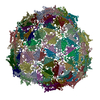
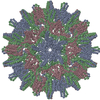
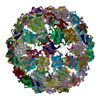
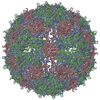
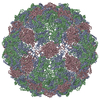
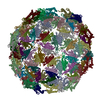


 PDBj
PDBj

